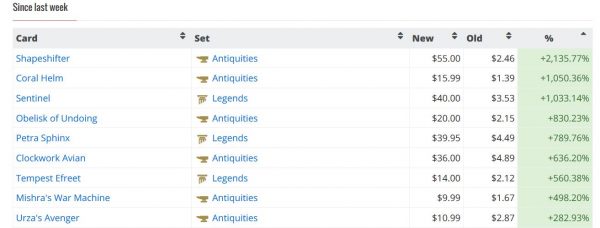Are you a Quiet Speculation member?
If not, now is a perfect time to join up! Our powerful tools, breaking-news analysis, and exclusive Discord channel will make sure you stay up to date and ahead of the curve.
In 2017 there was a significant run on Reserved List cards from Magic’s first four expansions: Arabian Nights, Antiquities, Legends, and The Dark. Even the most unplayable of cards saw their prices jump by hundreds of percent in a short period of time.
These buyouts were quite the boon, as they helped our Insiders make significant, low-risk money in a very short period of time. Indeed I cannot remember a time prior when I had so many sales on eBay over a thirty day span. In short, it was a fun time.
Then the hype quieted down: fewer and fewer of these cards showed up on MTG Stocks’ Interests page, buylists calmed down, and supply gradually dripped back into the market. All good things must end, I guess.
Now, over the past couple weeks we’ve had a remarkably similar type of move. But this time instead of Reserved List cards being targeted, it’s the non-Reserved List cards from Magic’s early sets that are going crazy.
Once again sales are picking up, buylists are starting to move and significant profits are available for the taking. I’ve already had some success moving cards like Bronze Horse and Coral Helm. But we know these spikes won’t last. This week I’ll share my strategy for outing these now-overpriced cards to try and maximize gains before prices calm back down again.
Option 1: eBay / TCGplayer
As supply drops on TCGplayer these cards start to show up on MTG Stocks. Then a distinct line is crossed when the only remaining copies are at silly-high prices (e.g. Escaped Shapeshifter at $55). This creates the 1000-percent-plus gain on MTG Stocks and the card suddenly leaps on everyone’s radar. A few uninformed speculators may scramble the internet to try to find copies as close to the “old price” as they can. Separately the people coordinating these buyouts (I truly believe this is coordinated) are looking across the internet to mop up copies that may have made it through the first pass.
This yields a very narrow window of opportunity. If you can list your copies for sale at 2-3 times the old price (still well below the silly price), you may set yourself up for a chance to make sizable gains. This is always my plan A. I don’t get greedy and list my card at a crazy price; instead, I list at a conceivable price.
For example, I saw Bronze Horse inventory was dropping quickly on TCGplayer. I picked up two copies at a couple bucks each. Then when the buyout occurred, the card spiked to $44 or so on MTG Stocks. Now you and I both know no one is purchasing this card for $44 unless it’s sporting a 9.5-10 grade. The price isn’t real. But that doesn’t mean this can’t be exploited.
I listed my first copy in the mid teens and it sold within a couple days. Then I listed my second one for a little higher and once again it sold. This is the ideal scenario. I didn’t try to list my copies at just under $44 because I knew no sale would be made. Instead, I listed the copy well above my purchase price but just low enough to give someone a reason to pick it up if they were experiencing some “fear of missing out.” For reference, here are some other recently sold prices. These can give you a guide on how I priced my cards relative to the old price and the silly new price that isn’t real.
Urza's Avenger: $9.25
Coral Helm: $5, $6
Tempest Efreet: $5
Horn of Deafening: $8
Brass Man: $10.25
Bishop of Rebirth: $6, $9.25
Psionic Entity: $16
None of these sales are life-changing. But considering my buy-in on these ranged from $0.50 to $3, you can see how profitable this endeavor becomes. You just have to price things realistically.
Option 2: Buylists
I’ve noticed a really convenient dynamic with these older cards over the years. As supply drops on eBay and TCGplayer and the prices jump, all major vendors of these cards get wiped out in the process. Then, some vendors react by adjusting their buylists. After all, they don’t want to be left with no copies in stock when so many people are visiting their site looking for a certain card.
In this way, buylists tend to lag the market and this leads to a favorable scenario. In case you fail to sell your recently spiked cards on eBay and TCGplayer, you have a viable backup plan in buylists. Now don’t expect to get $16 for a slightly played Psionic Entity from a buylist. That kind of price is not likely to be offered by even the most eager of vendors.
That’s why this is option two. Only after you come to the realization that flipping a card on TCGplayer/eBay may be difficult should you consider the buylist plan. I did this recently with Spring Mishra's Factory. I managed to sell a few copies on eBay into the buyout as it was happening. But once past, supply started to come back into the market. I was stuck holding one extra copy I didn’t want to keep. Sadly the price had already dropped back down and I had to price my copy at $28 just to be competitive. After no sales for a couple days, I started browsing buylists. That’s when I found it: Card Kingdom was paying $24.50 for NM copies. My copy wasn’t NM, but I suddenly had an out that made me money even after fees and shipping.
My margin is going to be very tiny on this card, but it sure beats a loss. If I really wanted to, I could have taken the store credit option. This would have netted me a 30% bonus, and I suspect I would have been able to find something favorable to buy with the credit. But in this case I took the cash and moved on. I did the same recently with an Ayesha Tanaka because after fees and shipping, I did not expect to get much more from eBay than I could have from Card Kingdom.
Any time the buyout passes and prices start to drop while you’re still holding copies, I recommend looking at buylists as a possible out. Card Kingdom and ABU Games are my favorite vendors to sell to for this endeavor.
Option 3: Hold Them or Fold Them
What happens if the TCGplayer price drops so quickly that buylists don’t even react? Then you are in a sticky situation and you have just two options. You can hold the cards and hope a speculator or market manipulator doubles back and buys out the card again. Or you could just dump the cards to the best buylist anyway, taking a small loss if applicable.
In my experiences, I have generally found that cashing out is a fine approach. It’s easy to convince yourself “these are all classic cards, they will go up eventually.” But the opportunity cost associated with this plan of action is fairly large. Perhaps not monetarily, but the time it may take for an unplayable card like Bishop of Rebirth to jump all over again could be fairly lengthy. Best to cash out and move on.
As long as you didn’t way overpay when you made your purchase, you should be able to at least break even by requesting store credit. With 30 percent trade-in bonus from Card Kingdom and 50 percent from ABU Games, it’s even likely you can come out ahead with store credit. Then you can sit on the credit and use it to pick up the next hot pick, whether it be an EDH foil or a Pauper card. By putting money to work elsewhere you maintain liquidity and ensure you are betting on cards you have highest confidence in. This is important because when dealing in useless ante cards like Tempest Efreet, you can’t even play with the cards while you wait. They are literally useless. So cash out and move on. It’s unlikely you’ll regret it. This isn’t necessarily the best play with Reserved List cards, which collectors will gradually drive up in value over time. But with reprinted unplayables, I have no doubt that cashing out is a fine play.
Wrapping It Up
After hitting all the Reserved List cards from Magic’s earliest expansions, the speculators have moved on reprinted rares from these sets. Last year’s run on Reserved List cards helped me to a record year for sales, and 2018 is off to a strong start thanks to the most recent buyouts. But things are a little different this time.
With these targeted cards not on the Reserved List, I don’t particularly like the long-term view of investing. Instead, I’d highly recommend flipping these cards to the first buyer willing to offer you more than you paid. TCGplayer and eBay are optimal ways to out cards, but buylists can offer a fallback plan if you can’t find a buyer desperate enough. Just remember you won’t get the silly $50 price tags currently listed for this stuff. Your best bet is to price 2-3 times above what you paid, likely in the $5-$15 range, and accept offers that net you a profit. Don’t be greedy and remain anxious to sell, and you will book profits.
If there’s not much traction on your listings, then don’t hesitate to pursue buylists. While the profits won’t be as juicy, you should still be able to net modest returns when shipping to vendors—especially when taking store credit. This is a sound backup plan that I activate time and again because I don’t want to be left holding the bag on these cards. Opportunities to sell Tempest Efreet and Bishop of Rebirth for $5-plus come rarely. There’s no sense trying to hold. Cash out and move onto the next spec. If nothing else you can use proceeds to try and anticipate the next buyout (my money’s still on Kei Takahashi and Voodoo Doll.
With these cards it’s all about liquidity, and making sure you’re selling out at the first opportunity for profit will help ensure you are successfully riding this speculation wave.
…
Sigbits
- Card Kingdom dropped their buylist on Juzám Djinn from $980 to $780 over the past week. One look at their stock for the card reveals why: they have seven total copies for sale! Ranging from $910 (good) to $1300 (near mint), their price point seems a little higher than what the market is willing to bear. I suspect the price will drift a little lower before finding equilibrium and climbing again.
- I’m focusing on Erhnam Djinn now because Card Kingdom continues to raise their buy price but remain out of stock on the card. Currently they’re offering $210 for near mint copies and they’re sold out at $300. My hope is they continue to increase buy price aggressively until they restock the card—a buy price of $250/copy would be an attractive exit point for anyone holding copies they want to sell.
- Another card I’m watching closely is Angus Mackenzie. Card Kingdom is sold out at $165 and their buy price is at an all time high, $120. There are a couple other Legends creatures also on the move. Pretty soon there will be a couple more that buylist for triple digits, and I really like holding these for the long haul because of their uniqueness and collectibility.











Also Legends rares are the rarest rares on the reserved list (ignoring Italian copies).
I didn’t know that. But are there really fewer of them than Arabian Nights “rares”? It must be close.